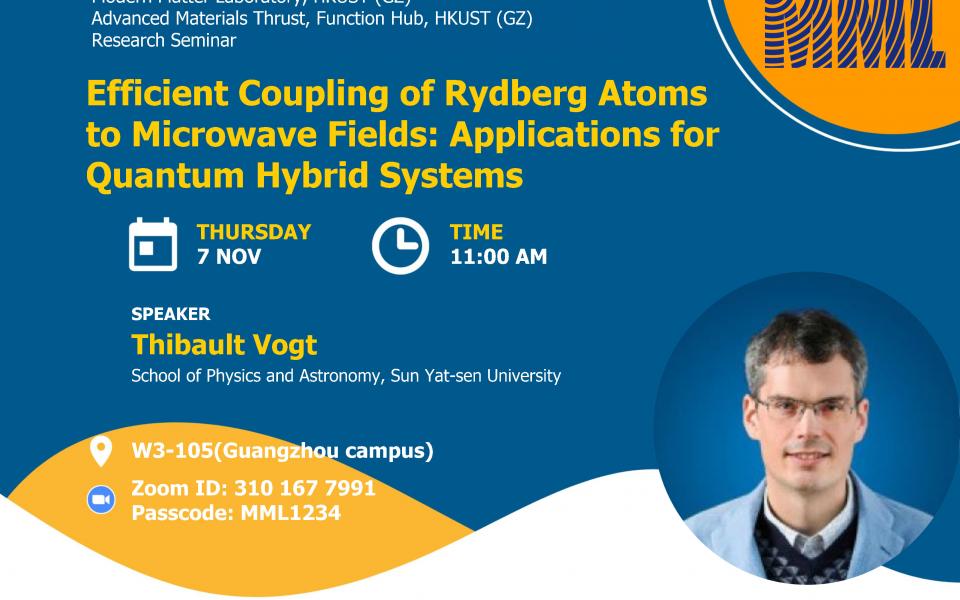MML Seminar - Efficient Coupling of Rydberg Atoms to Microwave Fields: Applications for Quantum Hybrid Systems
Supporting the below United Nations Sustainable Development Goals:支持以下聯合國可持續發展目標:支持以下联合国可持续发展目标:
The coupling of Rydberg atoms with electric fields from continuous DC to microwave is orders of magnitude larger than that of ground state atoms. Furthermore, Rydberg atoms are easily obtained by laser excitation of neutral atoms, hence can become perfect mediators for interfacing neutral atoms with other quantum systems featuring large electric fields such as superconducting (SC) microwave resonators or ions. In this seminar, I will focus on the coupling of atoms with the two later systems.
In the first part of the presentation, I report on our recent works on SC-atom quantum-hybrid systems. I first discuss our theoretical study of a hybrid atom-microwave photon quantum gate capable of efficiently entangling the field of a microwave resonator and one neutral atom qubit [1]. Then I discuss our most recent work on microwave-optical conversion, the idea being to couple SC qubit systems with optical photons via four-wave mixing in Rydberg atoms for enabling long-distance communications between remote SC quantum processors [2]. I review the conditions that optimize both off-resonant and all-resonant frequency mixing and allow for achieving near-unit photon conversion efficiency at low microwave powers [3]. I also present our experimental progress towards realizing efficient microwave-optical conversion via four-wave mixing in cesium vapors, for conversion of microwave photons at 9.9 GHz into infrared photons (852 nm).
In the second part of the presentation, I show how Rydberg atoms can be used for probing and imaging the electric field created by ions embedded in an atomic gas, allowing for the fast detection of the ions [3-4]. Rydberg energy levels of atoms are subject to huge Stark effects in the vicinity of an ion. When the ion-atom mixture is being driven in condition of electromagnetically induced transparency (EIT) involving a Rydberg state, the ions within the atomic cloud induce enhanced scattering of the probe light in their surrounding due to a phenomenon similar to photon blockade. While shadow imaging of the probe light was employed for imaging the ions in our previous work, a recent improvement making use of homodyne detection with a strong reference beam allows us to realize imaging in a single shot with only one microsecond exposure time [4].
[1] W. Yu, Q. Yin, Y. Liang, N. Ji, and T. Vogt*, Error-robust hybrid atom-photon entangling gate via Gaussian soft control, JOSAB 41, 2463-2468 (2024)
[2] N. Ji, Y. Liang, W. Yu, Q. Yin, and T. Vogt*, Optimizing Four-Wave Mixing in Rydberg Atoms for Microwave-Optical Conversion, Arxiv:2405.14263 (2024)
[3] C. Gross#, T. Vogt#*, and W. Li*, Ion Imaging via Long-Range Interaction with Rydberg Atoms, Phys. Rev. Lett. 124, 053401 (2020).
[4] D. Jinjin#, T. Vogt#*, and W. Li*, Fast Single-shot Imaging of Individual Ions via Homodyne Detection of Rydberg Blockade Induced Absorption, Phys. Rev. Lett. 124, 053401 (2023)
Thibault Vogt has been Associate professor at Sun Yat-sen university since December 2020. His main research focus is about using Rydberg atoms for quantum information processing, quantum communications and microwave/THz technologies.
Thibault Vogt has published 25 SCI articles. He is well-known for his contribution to the demonstration of the so-called resonant dipole blockade whereby the laser excitation of nearby atoms to Rydberg state is blocked due to large dipole-dipole interactions.
